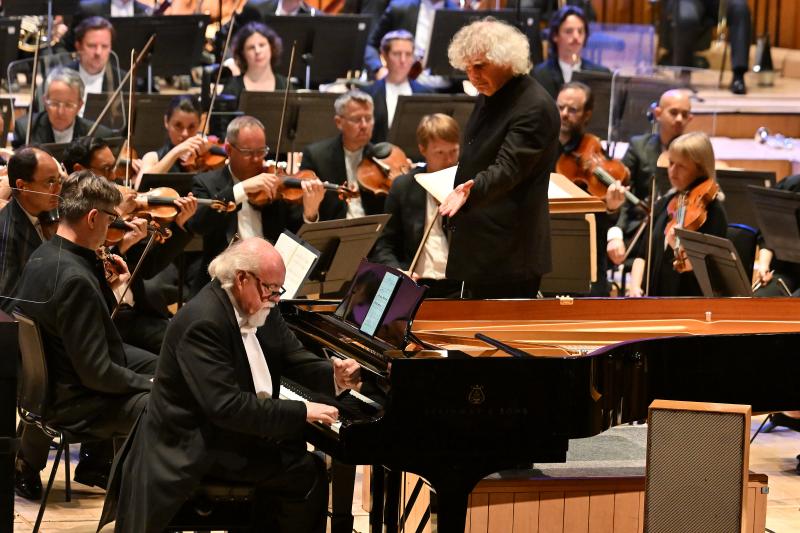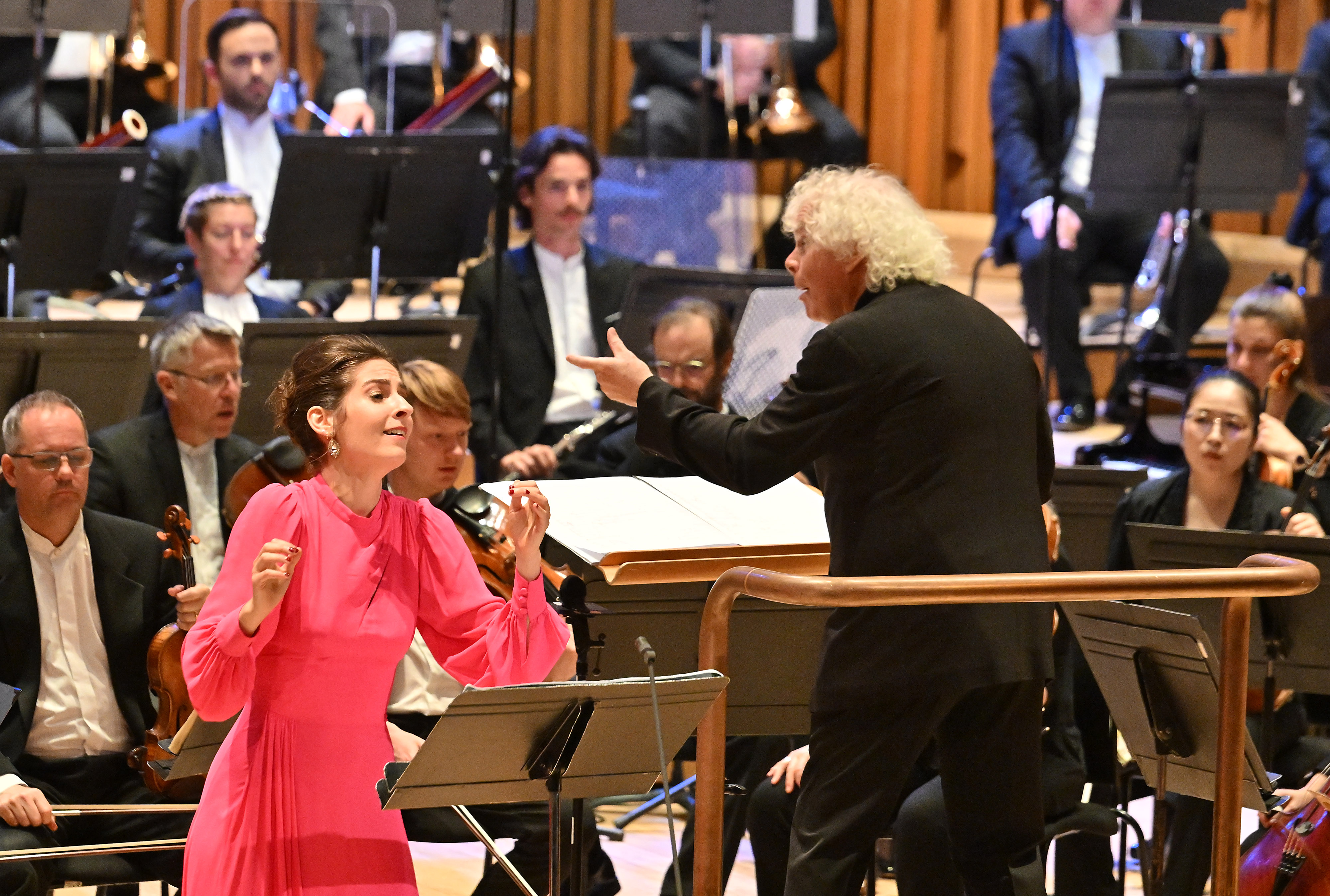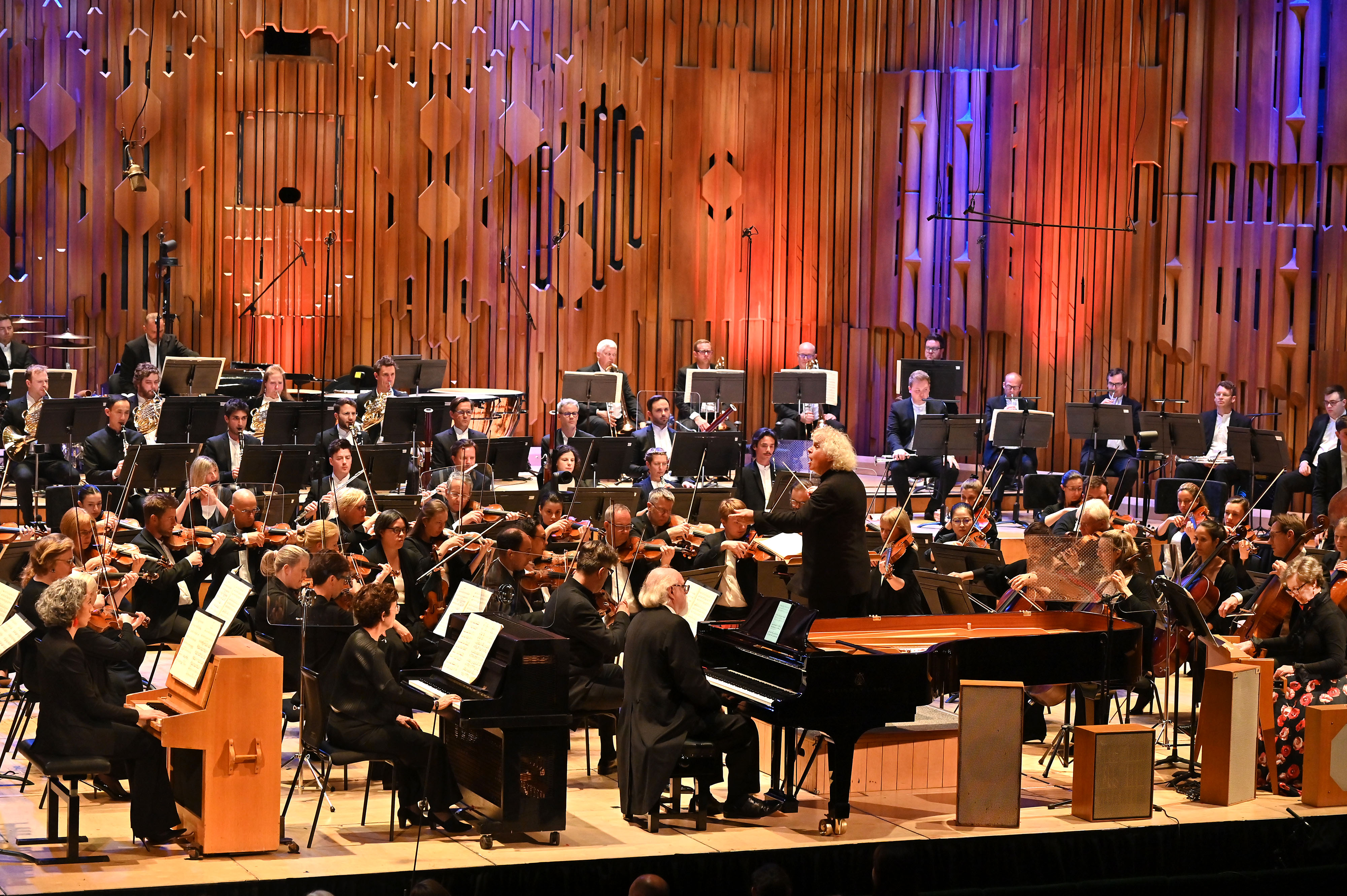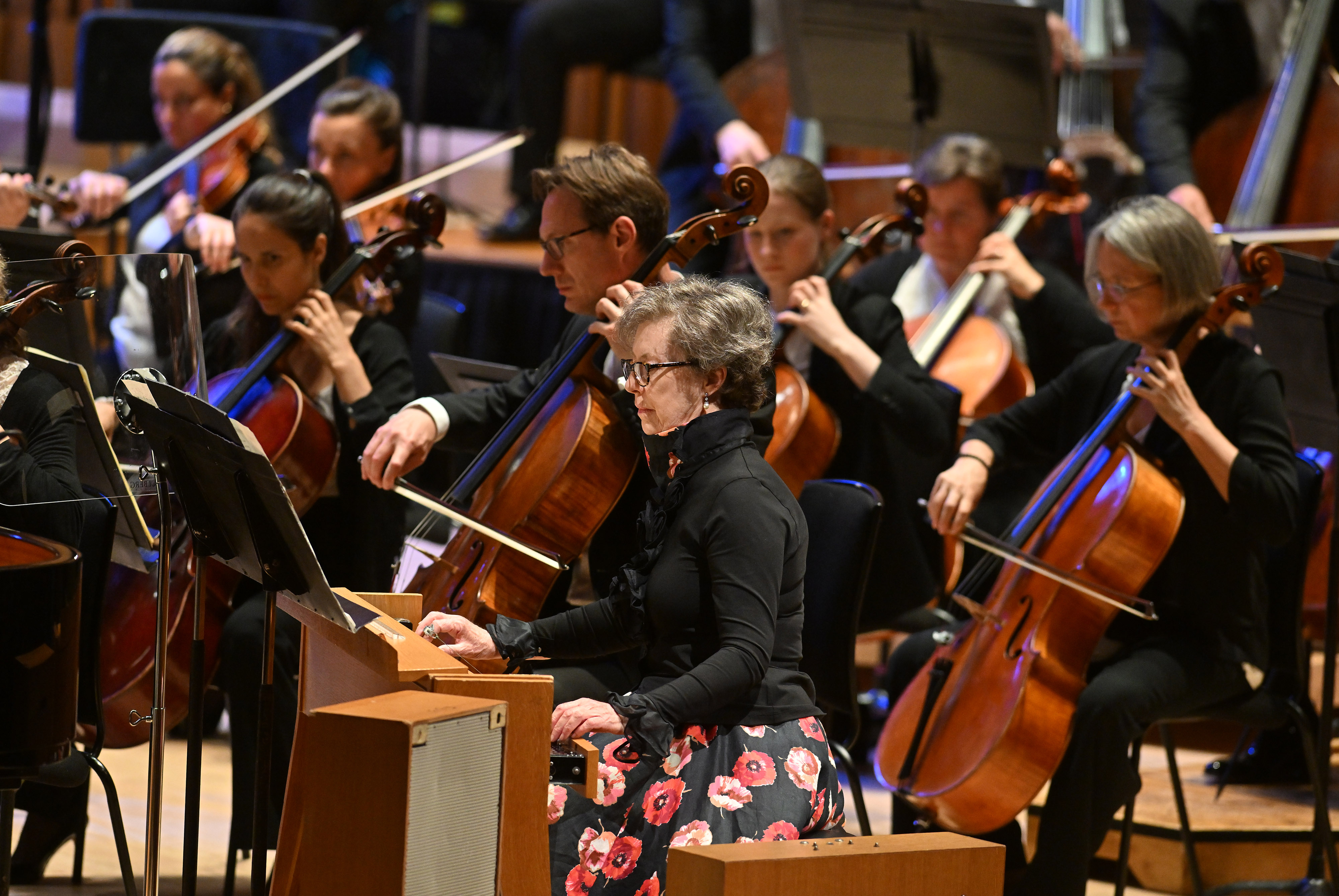Turangalîla-Symphonie, LSO, Rattle, Barbican review - a farewell night to remember | reviews, news & interviews
Turangalîla-Symphonie, LSO, Rattle, Barbican review - a farewell night to remember
Turangalîla-Symphonie, LSO, Rattle, Barbican review - a farewell night to remember
Sir Simon signs off in London with magnificent Messiaen

Simon Rattle’s farewell season as music director of the London Symphony Orchestra has inscribed a sort of artistic memoir as he moves from one of his beloved blockbusters to another. Last night, he closed his account at the Barbican (though he will regularly return as “Conductor Emeritus”) with Messiaen’s mighty Turangalîla-Symphonie.
Under the baton of Sir Charles Groves, it thrilled him as a kid in Liverpool. It thrilled us, too, as the composer’s ecstatic, unbuttoned post-Second World War shout of love and joy drew from the LSO the most ferociously uplifting performance anyone could wish to hear. Devotees of the meditative, exploratory Messiaen might have felt that Rattle’s magnificently brash and jazzy extraversion put some of the epic work’s subtler tones in the shade. But Rattle’s peaks – there were many – joyously touched those stars that Messiaen so deliriously evokes.
We began in a quieter, though connected, vein, with the world premiere of Ces belles années… by the 96-year-old Betsy Jolas. Rattle has helped to nurture the well-deserved re-flowering of the Franco-American composer’s career. It felt extraordinary to hear probing, vital new work from a figure who grew up in inter-war Paris surrounded by the great names – Joyce, Hemingway etc – whom her parents published in transition magazine. Ces belles années… begins with mutating orchestral colours but then arranges stock phrases of recollection and celebration, of “all these beautiful days, these beautiful years”, into a prose-poem for solo voice: the robust, rich-hued soprano of Faustine de Monès (pictured below). Expressively sung, the text speaks of memories that bring joy as time passes and new generations rise.
From plangent bells to lush, but curtailed, string lines, Jolas’s strongly accented phrases do hint at a nostalgic lyricism as snatches of remembered beauty pass around the orchestra. But there are more abrasive, even sinister, sonic forces at work here too, from unsettling percussion growls and brittle figures in the brass to moments when the strings down their bows to clap and stamp instead. Jolas ends with a burst of laughter that sounded at least as much like a demonic cackle as an outburst of delight. Overall, we heard both the bright and dark sides of long memory in a piece that, for me, summoned up the spirit of yet another transition contributor: none other than Samuel Beckett. There was, though, no ambiguity in the acclaim that greeted Jolas herself when Rattle went to find her in the auditorium.
 For the Turangalîla-Symphonie, Messian famously enhances his percussion-heavy orchestra not only with a solo pianist (here, Peter Donohoe) and other conventional keyboards but his beloved Ondes Martenot. As she often, and incomparably, does, Cynthia Millar played the wavy, spooky proto-synthesisier, sitting on one side of Rattle with Donohue and his fellow-keyboardists (Elizabeth Burley’s celeste, Zeynep Özsuca’s keyed glockenspiel; pictured below with Peter Donohue) on the other. From my seat, this arrangement created the occasional balance issue, with the ondes not always prominent enough in busier orchestral sections – although truly mesmerising in their uncanny, extraterrestrial timbres during those episodes when Millar played alone or in dialogue with other instruments.
For the Turangalîla-Symphonie, Messian famously enhances his percussion-heavy orchestra not only with a solo pianist (here, Peter Donohoe) and other conventional keyboards but his beloved Ondes Martenot. As she often, and incomparably, does, Cynthia Millar played the wavy, spooky proto-synthesisier, sitting on one side of Rattle with Donohue and his fellow-keyboardists (Elizabeth Burley’s celeste, Zeynep Özsuca’s keyed glockenspiel; pictured below with Peter Donohue) on the other. From my seat, this arrangement created the occasional balance issue, with the ondes not always prominent enough in busier orchestral sections – although truly mesmerising in their uncanny, extraterrestrial timbres during those episodes when Millar played alone or in dialogue with other instruments.
Otherwise, Rattle turned the Turangalîla into an absolute blast, with roof-shaking tutti climaxes along with pinpoint exuberance in the work's endlessly inventive interplay of instrumental textures. Too much stress on Messiaen’s learned fascination for Indian polyrhythms, his immersion in Tristan und Isolde, or his cosmic Catholic mysticism, can muffle the sheer, hedonistic jubilation that brands the 80-odd minutes of the work from start to finish. Remember, it was Leonard Bernstein who conducted the premiere (in 1949). Rattle summoned all his inner Lennie to deliver a Jazz Age masterpiece that had me thinking of Gershwin (even Ellington) as often as of Wagner. Irrepressible rhythmic vitality joined with unabashed showmanship in the climatic scenes to transform the LSO into the ultimate avant-garde Big Band. Rattle does this kind of modernist mega-entertainment supremely well, and he never stinted on cheek, swagger and pizzazz.
 From the opening trombone crunch of the “statue” theme, and the answering lyricism of the clarinets and their “flower” motif, the LSO brass and woodwind put their stamp on the show with formidable control and dense, savoury flavours. It's the percussion, though, that strike the decisive blows – in every sense – at so many key junctures throughout the work. From glocks to blocks, tambourine to vibraphone, the ten-strong artillery in the rear duly made their outsize contribution to the impact of the whole. As for Donohoe’s solo piano excursions, and muscular face-offs with the orchestra: the massive part amounts to a double-length concerto in itself, and he somehow found refined delicacy and inwardness along the way as well as (when required) spells of smashing forcefulness.
From the opening trombone crunch of the “statue” theme, and the answering lyricism of the clarinets and their “flower” motif, the LSO brass and woodwind put their stamp on the show with formidable control and dense, savoury flavours. It's the percussion, though, that strike the decisive blows – in every sense – at so many key junctures throughout the work. From glocks to blocks, tambourine to vibraphone, the ten-strong artillery in the rear duly made their outsize contribution to the impact of the whole. As for Donohoe’s solo piano excursions, and muscular face-offs with the orchestra: the massive part amounts to a double-length concerto in itself, and he somehow found refined delicacy and inwardness along the way as well as (when required) spells of smashing forcefulness.
Rattle made the “Chant d’Amour” sections into full-blooded orgies of sonic sensuality with the strings (to my ears) channelling not just Wagnerian unctuousness but a swooping, swooning, Hollywood-studio sound. Tristan meets South Pacific: What’s not to love? And Rattle’s Bernstein tribute came utterly off the leash in the “Joy of the Blood of the Stars” movement, its dancehall exhilaration skirting the edge of chaos as the LSO built towards another shattering FFF climax.
 It wasn’t all unremitting noise and blaze. Rattle found some exquisite muted colours in the enchanted nocturne of the “Garden of the Sleep of Love” – with Millar’s ondes (pictured above) gloriously centre-stage – and made me hear more clearly than before how the relatively austere, uncompromising “Turangâlila” episodes cleanse the palate between one sensuous starburst and the next. And he did find moments of time-stopping hush – as when the full-spectrum ecstasy of the “Development of Love” section dwindles into an endless, reverberating fade. Yet, in the end, the unbridled euphoria of Messiaen’s love theme trumps every other mood. Rattle steered us into the electrifying final dance in the company of his snorting, hefty brass and languid, caressing strings (led by Roman Simovic). The closing crescendo engulfed us as a thing of terrifying beauty – as, indeed, was the clamorous epic as a whole. On this barnstorming form, Rattle leaves for Munich with his place among the brightest stars assured.
It wasn’t all unremitting noise and blaze. Rattle found some exquisite muted colours in the enchanted nocturne of the “Garden of the Sleep of Love” – with Millar’s ondes (pictured above) gloriously centre-stage – and made me hear more clearly than before how the relatively austere, uncompromising “Turangâlila” episodes cleanse the palate between one sensuous starburst and the next. And he did find moments of time-stopping hush – as when the full-spectrum ecstasy of the “Development of Love” section dwindles into an endless, reverberating fade. Yet, in the end, the unbridled euphoria of Messiaen’s love theme trumps every other mood. Rattle steered us into the electrifying final dance in the company of his snorting, hefty brass and languid, caressing strings (led by Roman Simovic). The closing crescendo engulfed us as a thing of terrifying beauty – as, indeed, was the clamorous epic as a whole. On this barnstorming form, Rattle leaves for Munich with his place among the brightest stars assured.
The future of Arts Journalism
You can stop theartsdesk.com closing!
We urgently need financing to survive. Our fundraising drive has thus far raised £49,000 but we need to reach £100,000 or we will be forced to close. Please contribute here: https://gofund.me/c3f6033d
And if you can forward this information to anyone who might assist, we’d be grateful.

Subscribe to theartsdesk.com
Thank you for continuing to read our work on theartsdesk.com. For unlimited access to every article in its entirety, including our archive of more than 15,000 pieces, we're asking for £5 per month or £40 per year. We feel it's a very good deal, and hope you do too.
To take a subscription now simply click here.
And if you're looking for that extra gift for a friend or family member, why not treat them to a theartsdesk.com gift subscription?
more Classical music
 Bizet in 150th anniversary year: rich and rare French offerings from Palazzetto Bru Zane
Specialists in French romantic music unveil a treasure trove both live and on disc
Bizet in 150th anniversary year: rich and rare French offerings from Palazzetto Bru Zane
Specialists in French romantic music unveil a treasure trove both live and on disc
 Scottish Chamber Orchestra, Ibragimova, Queen’s Hall, Edinburgh review - rarities, novelties and drumrolls
A pity the SCO didn't pick a better showcase for a shining guest artist
Scottish Chamber Orchestra, Ibragimova, Queen’s Hall, Edinburgh review - rarities, novelties and drumrolls
A pity the SCO didn't pick a better showcase for a shining guest artist
 Kilsby, Parkes, Sinfonia of London, Wilson, Barbican review - string things zing and sing in expert hands
British masterpieces for strings plus other-worldly tenor and horn - and a muscular rarity
Kilsby, Parkes, Sinfonia of London, Wilson, Barbican review - string things zing and sing in expert hands
British masterpieces for strings plus other-worldly tenor and horn - and a muscular rarity
 From Historical to Hip-Hop, Classically Black Music Festival, Kings Place review - a cluster of impressive stars for the future
From quasi-Mozartian elegance to the gritty humour of a kitchen inspection
From Historical to Hip-Hop, Classically Black Music Festival, Kings Place review - a cluster of impressive stars for the future
From quasi-Mozartian elegance to the gritty humour of a kitchen inspection
 Shibe, LSO, Adès, Barbican review - gaudy and glorious new music alongside serene Sibelius
Adès’s passion makes persuasive case for the music he loves, both new and old
Shibe, LSO, Adès, Barbican review - gaudy and glorious new music alongside serene Sibelius
Adès’s passion makes persuasive case for the music he loves, both new and old
 Anja Mittermüller, Richard Fu, Wigmore Hall review - a glorious hall debut
The Austrian mezzo shines - at the age of 22
Anja Mittermüller, Richard Fu, Wigmore Hall review - a glorious hall debut
The Austrian mezzo shines - at the age of 22
 First Person: clarinettist Oliver Pashley on the new horizons of The Hermes Experiment's latest album
Compositions by members of this unusual quartet feature for the first time
First Person: clarinettist Oliver Pashley on the new horizons of The Hermes Experiment's latest album
Compositions by members of this unusual quartet feature for the first time
 Gesualdo Passione, Les Arts Florissants, Amala Dior Company, Barbican review - inspired collaboration excavates the music's humanity
At times it was like watching an anarchic religious procession
Gesualdo Passione, Les Arts Florissants, Amala Dior Company, Barbican review - inspired collaboration excavates the music's humanity
At times it was like watching an anarchic religious procession
 Classical CDs: Camels, concrete and cabaret
An influential American composer's 90th birthday box, plus British piano concertos and a father-and-son duo
Classical CDs: Camels, concrete and cabaret
An influential American composer's 90th birthday box, plus British piano concertos and a father-and-son duo
 Cockerham, Manchester Camerata, Sheen, Martin Harris Centre, Manchester review - re-enacting the dawn of modernism
Two UK premieres added to three miniatures from a seminal event of January 1914
Cockerham, Manchester Camerata, Sheen, Martin Harris Centre, Manchester review - re-enacting the dawn of modernism
Two UK premieres added to three miniatures from a seminal event of January 1914
 Kempf, Brno Philharmonic, Davies, Bridgewater Hall, Manchester review - European tradition meets American jazz
Bouncing Czechs enjoy their Gershwin and Brubeck alongside Janáček and Dvořák
Kempf, Brno Philharmonic, Davies, Bridgewater Hall, Manchester review - European tradition meets American jazz
Bouncing Czechs enjoy their Gershwin and Brubeck alongside Janáček and Dvořák
 Solomon, OAE, Butt, QEH review - daft Biblical whitewashing with great choruses
Even a top soprano and mezzo can’t make this Handel paean wholly convincing
Solomon, OAE, Butt, QEH review - daft Biblical whitewashing with great choruses
Even a top soprano and mezzo can’t make this Handel paean wholly convincing

Add comment